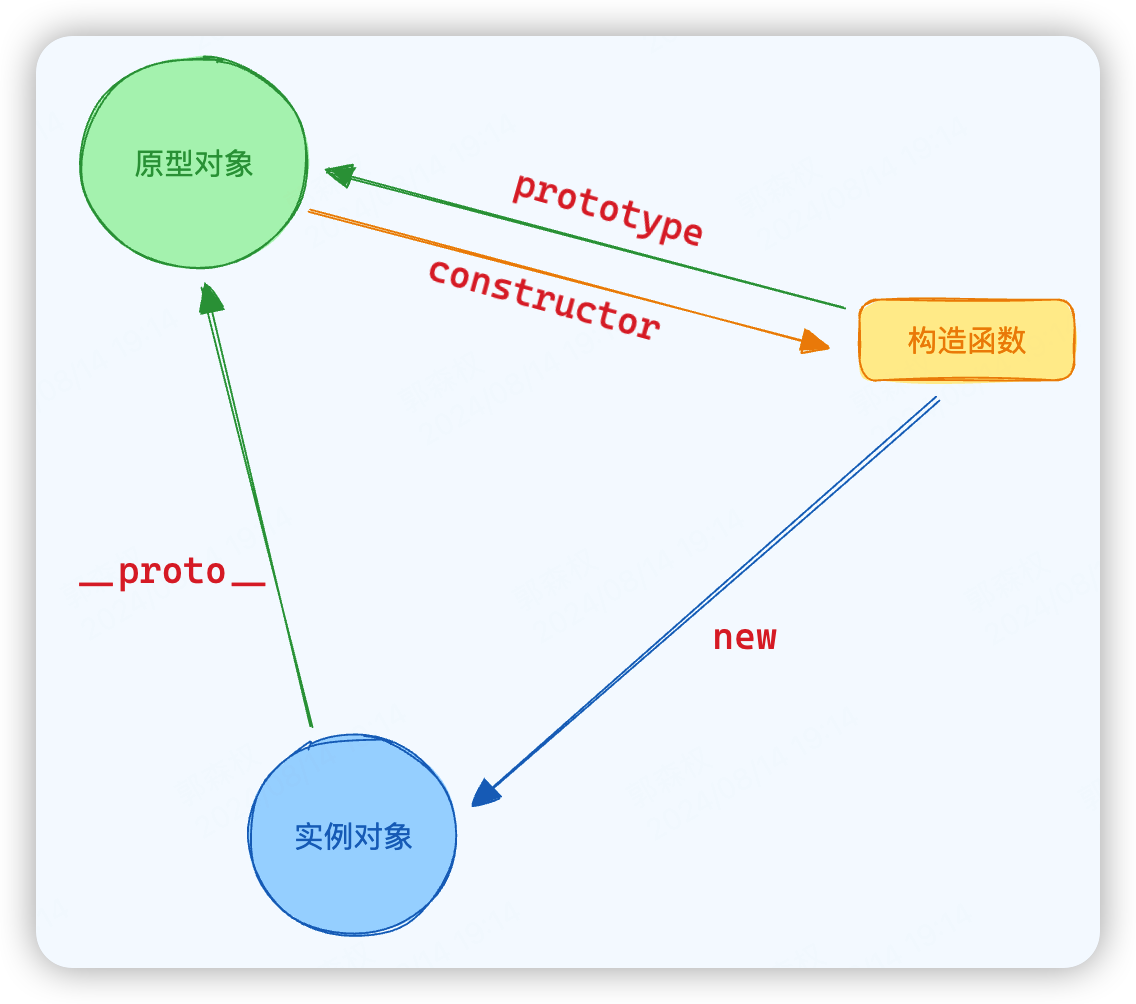原型与原型链
省流:
原型和原型链是 JS 实现面向对象的手段。
每个对象都有一个
__proto__属性,该属性指向自己的原型对象每个构造函数都有一个
prototype属性,该属性指向实例对象的原型对象
- 即
实例.__proto__ === 构造函数.prototype原型对象的
constructor指向构造函数本身
每个对象都有自己的原型对象,而原型对象本身也有自己的原型对象,从而形成了一条链条
当试图访问一个对象的属性时,不仅会找对象的自有属性,也会顺着原型链找这个属性
1 原型链
1.1 什么是原型链(举例)
JS中一切皆对象,只要是对象就有一个隐藏属性
__proto__(Object.prototype除外),指向(全等于)其构造函数的原型(prototype)children.__proto__ === Parent.protytpe
__proto__属性的作用就是指向对象的原型的,告诉对象其构造函数的原型是谁比如说有个数组 a,那么 a 的隐藏属性
__proto__指向 a 构造函数的原型,即Array.prototype,而 Array.prototype 也有隐藏属性__proto__,指向Object.prototype,因为全部对象的祖先原型都是 Object.prototypea.__proto__ === Array.prototype;
Array.prototype.__proto__ === Object.prototype至此,数组 a、Array.prototype 与Object.prototype 就通过隐藏属性
__proto__形成了一条原型链特点
- 函数本身作为自身原型对象的构造函数
- 实例的
__proto__属性(原型)等于其构造函数的prototype属性 - 所有对象的祖先原型都是
Object.prototype
1.2 如何实现原型链
访问原型对象的方式
构造函数.prototype实例对象.__proto__(不推荐)Object.getPrototypeOf(实例对象)(推荐)
原型链实现的本质就是改变对象的隐藏属性
__proto__,使其指向另外一个对象但不推荐直接赋值更改
const x = Object.create(新原型对象)const x = new 新原型的构造函数()
1.3 优点/意义
原型与原型链在 JS 中的唯一作用/意义就是实现面向对象
在没有 Class 的情况下实现继承,比如
[] => Array.prototype => Object.prototype的原型链
1.4 缺点
不支持私有属性,只能靠下划线作为前缀来约定私有属性(在 class 中利用
#作为前缀来定义私有属性)写起来较复杂
2 继承
2.1 原型链继承
子类的原型对象指向父类的实例对象
// 构造函数Parent
function Parent () {
// 构造函数中的实例属性
this.name = 'gsq'
this.array = [1, 2, 3]
}
// 原型属性
Parent.prototype.array2 = [4, 5, 6]
// 原型方法
Parent.prototype.say(){
console.log('say something')
}
// 构造函数Child
function Child () {}
// 原型链继承核心
Child.prototype = new Parent()
// 可有可无的细节:
// 重新建立子类实例与子类构造函数的联系
Object.defineProperty(Child.prototype, "constructor", {
value: Child,
enumerable: false,
writable: true
})
// 实例化Child
const c1 = new Child()
const c2 = new Child()
// 实例对象c能够访问到Parent构造函数的实例属性以及Parent原型对象的属性
console.log(c1.array) // [1, 2, 3]
console.log(c2.array2) // [4, 5 ,6]
c1.say()
c2.say()
/* 重点来啦 */
// 尝试改变对象继承的属性
c1.name = 'zs'
c1.array.push(4)
c1.array2.push(7)
// 会发现实例对象c2继承的引用属性发生了改变
console.log(c2.name) // 原始类型没有被影响,仍然是gsq
console.log(c2.array) // 变为 [1, 2, 3, 4]
console.log(c2.array2) // 变为 [4, 5 ,6 ,7]- 优点:实现了原型对象属性与方法的继承
- 缺点:存在引用类型属性共享的问题,无法实现多继承
2.2 构造函数继承
- 子类构造函数借用父类构造函数
// 父类构造函数
function Parent(){
// 实例属性(引用类型)
this.array = [1, 2, 3]
}
// 原型属性
Parent.prototype.title = 'gsq'
// 子类构造函数
function Son(){
// * 借用父类的构造函数
// 变更Parent执行时内部的this指向为实例对象
Parent.call(this)
}
// 实例化
const s1 = new Son()
const s2 = new Son()
// 解决了引用值不会共享的问题
s1.array.push(4)
console.log(s2.array) // 仍然是 [1,2,3]
// 但访问不了父类原型对象的属性与方法
s2.title // undefined
- 优点:解决了原型链继承引用值共享的问题,可以实现多继承
- 缺点:只能继承父类的实例属性和方法,不能继承原型对象的属性和方法
2.3 组合继承(伪经典继承)
- 原型链继承结合构造函数继承
function Parent(){
// 实例属性(引用类型)
this.array = [1, 2, 3]
}
// 原型方法
Parent.prototype.say = function (){
console.log("say sth")
}
// 构造函数继承
function Son(){
Parent.call(this)
}
// * 原型链继承
Son.prototype = new Parent()
const s1 = new Son()
const s2 = new Son()
// 不会出现引用类型属性共享的问题
s1.array.push(4)
console.log(s2.array) // [1,2,3]
// 同时也可以访问父类原型上的方法
s2.say() // "say sth"
- 优点:解决原型链继承和构造函数继承的问题
- 缺点:父类的构造函数复用的问题(执行两次)
2.4 寄生组合继承(经典继承)
- 利用
Object.create()方法,指定子类原型对象的父类原型对象(不再通过父类实例) var B = Object.create(A):以A对象为原型,生成了B对象。B继承了A的所有属性和方法。
function Parent(){}
function Son(){
Parent.call(this)
}
// * Son的原型直接继承Parent的原型
Son.prototype = Object.create(Parent.prototype)
// Object.create等同于
Object.create = function (proto) {
function F() {}
F.prototype = proto;
return new F();
};
- 优点:优化了组合继承中父类构造函数的复用的问题
- 缺点:重写了子类的原型,会导致子类的属性与方法无法访问
2.5 ES6 继承
class Father {
age = 60;
gender = "male";
constructor(age) {
this.age = age;
}
getAge() {
return this.age;
}
static getName() {
return "father";
}
}
class Son extends Father {
constructor(name, age) {
/*
子类必须在constructor方法中调用super方法,否则新建实例时会报错。
这是因为子类自己的this对象,必须先通过父类的构造函数完成塑造,得到与父类同样的实例属性和方法,
然后再对其进行加工,加上子类自己的实例属性和方法。
如果不调用super方法,子类就得不到this对象。
*/
super(age);
this.name = name;
}
}
const son = new Son("gsq", 90);
console.log(son);
Son { age: 90, gender: 'male', name: 'gsq' }
面试题
// 构造函数
function Foo(){
// 挂载到 window 对象的全局函数
// 在 Foo 函数被调用时才会声明
getName = function(){
cosole.log(1)
}
return this
}
// 静态方法
Foo.getName = function(){
console.log(2)
}
// 原型方法
Foo.prototype.getName = function (){
console.log(3)
}
// 函数表达式
// 函数表达式
// 解释器分析到这句才会正式给 var getName 赋值
var getName = function (){
console.log(4)
}
// getName 函数声明,会优先提升到作用域顶端
// 会被更早覆盖掉
function getName(){
console.log(5)
}
/*-------------------------*/
console.log(Foo()) // 独立调用执行,返回值this指向window对象 // window
Foo.getName() // 调用类的静态方法 2
3 new 做了什么
创建临时对象
const obj = {}将临时对象的
__proto__指向构造函数的原型(绑定原型,获取构造函数原型链上的共有属性)obj.__proto__ = Con.prototype
Object.setPrototypeOf(obj, Con.prototype)使用 call 或 apply 执行构造函数,将临时对象 obj 作为 this (同时赋值,获取自身属性)
const result = Con.apply(obj, ...args)返回结果对象
return result
面试
function Foo() {
// 静态方法 a
Foo.a = function () {
console.log(1);
};
// 实例的方法 a
this.a = function () {
console.log(2);
};
}
// Foo 原型方法 a
Foo.prototype.a = function () {
console.log(4);
};
// Function 原型方法 a
Function.prototype.a = function () {
console.log(3);
};
// 还没执行 Foo,Foo 目前就是个函数,属于 Function 的实例
// 所以目前还没有 a 静态方法,所以去 Function 原型上找 3
Foo.a();
// 调用了 Foo,Foo 有静态方法了,且实例方法 a 也有了
let obj = new Foo();
// 实例的 a 2
obj.a();
// 静态的 a 1
Foo.a();
